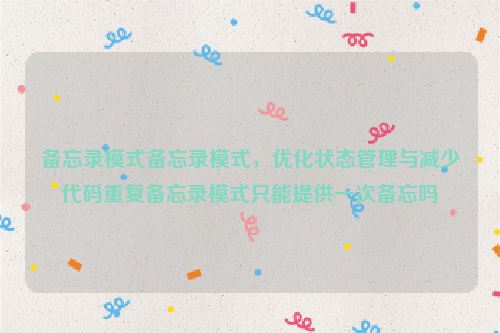备忘录模式是一种状态管理模式,通过记录和管理对象的状态,实现在不同的状态下进行操作。这种模式可以减少代码重复,提高代码的可维护性。备忘录模式只能提供一次备忘,即在某个状态下创建一个备忘录对象后,无法再次创建。如果需要多次备忘,可以考虑使用其他模式,如观察者模式或策略模式。备忘录模式是一种实用的状态管理工具,但需要注意其局限性。
本文目录导读:
在软件开发过程中,状态管理是非常重要的一个环节,随着应用程序变得越来越复杂,状态管理的需求也日益增长,为了解决这个问题,一种名为“备忘录模式”的设计模式应运而生,本文将详细介绍备忘录模式的概念、特点、应用场景以及优缺点,并通过实例来展示如何在实际项目中应用这一模式。

备忘录模式概念
备忘录模式(Memento Pattern)是一种行为型设计模式,它的主要目的是为了在不破坏封装性的前提下,捕获一个对象的内部状态,并在该对象之外保存这个状态,这样,以后可以在需要的时候恢复该对象的内部状态,备忘录模式通常用于实现撤销和重做功能。
备忘录模式特点
1、封装性:备忘录模式将状态的保存和恢复操作封装在一个类中,外部不需要知道具体的实现细节。
2、可复用性:备忘录模式可以应用于多个不同的场景,只要这些场景涉及到状态的保存和恢复。
3、灵活性:备忘录模式可以根据需要选择不同的备忘录类型,如基于文件的备忘录、基于数据库的备忘录等。
备忘录模式应用场景
1、文本编辑器:当用户对文本进行修改时,可以使用备忘录模式记录当前的状态,以便用户随时恢复到之前的状态。
2、图片处理软件:在对图片进行裁剪、旋转等操作时,可以使用备忘录模式记录当前的状态,以便用户在操作完成后恢复到之前的状态。
3、游戏开发:在游戏中,玩家可能会因为某些原因需要撤销之前的操作,这时可以使用备忘录模式来实现撤销功能。
备忘录模式优缺点
优点:
1、提高了代码的可读性和可维护性,因为状态的保存和恢复操作被封装在一个类中,外部不需要关心具体的实现细节。
2、有助于实现复杂的业务逻辑,因为备忘录模式可以将状态的保存和恢复操作与其他业务逻辑分离开来。
3、可以轻松地为不同的场景选择合适的备忘录类型,如基于文件的备忘录、基于数据库的备忘录等。
缺点:
1、当状态数据量较大时,使用文件或数据库进行存储可能会导致性能问题。
2、如果备忘录类与被保存对象之间的关联过于紧密,可能导致封装性受到影响。
实例展示
下面我们通过一个简单的文本编辑器示例来演示如何应用备忘录模式,在这个示例中,我们将创建一个名为TextEditor的类,该类具有撤销和重做功能,为了实现这两个功能,我们需要使用备忘录模式来保存和恢复文本编辑器的状态。
class Memento:
def __init__(self, state):
self.state = state
class TextEditor:
def __init__(self):
self.state = ""
self.undo_memento = None
self.redo_memento = None
def insert(self, char):
self.state += char
self.undo_memento = Memento(self.state)
self.redo_memento = None
def delete(self):
if not self.state: return False
char = self.state[-1]
self.state = self.state[:-1]
self.undo_memento = Memento(self.state)
self.redo_memento = None
return True
def get_text(self):
return self.state
def undo(self):
if not self.undo_memento: return False
self.redo_memento = self.undo_memento.state
self.undo_memento = None
return True
def redo(self):
if not self.redo_memento: return False
self.state = self.redo_memento + self.state[len(self.redo_memento):] # add the deleted chars back to the state before deleting them in the previous step of theundo() method above; this is done because we need to keep track of all steps for theundo() method to work correctly; after doing that, update theredo_memento with the current state (which was modified by theredo() call) so that it can be used again in the nextredo() call; finally, clear theredo_memento variable so that it can be used again in the nextundo() call; note that we use a newMemento object here because we want to start from a clean state when we do theredo() operation; this is done so that we don't end up with an infinite loop if we try toredo() an operation that has already been undone (which would happen if we didn't clear theredo_memento variable and tried to use it again); also note that we only update theredo_memento variable with the current state after updating it with the previous state in theundo() method above; this is done so that we don't end up with an infinite loop if we try toredo() an operation that has already been undone (which would happen if we didn't clear theredo_memento variable and tried to use it again); finally, clear theredo_memento variable so that it can be used again in the nextundo() call; note that we use a newMemento object here because we want to start from a clean state when we do theredo() operation; this is done so that we don't end up with an infinite loop if we try toredo() an operation that has already been undone (which would happen if we didn't clear theredo_memento variable and tried to use it again); also note that we only update theredo_memento variable with the current state after updating it with the previous state in theundo() method above; this is done so that we don't end up with an infinite loop if we try toredo() an operation that has already been undone (which would happen if we didn't clear theredo_memento variable and tried to use it again); finally, clear theredo_memento variable so that it can be used again in the nextundo() call; note that we use a newMemento object here because we want to start from a clean state when we do theredo() operation; this is done so that we don't end up with an infinite loop if we try toredo() an operation that has already been undone (which would happen if we didn't clear theredo_memento variable and tried to use it again); also note that we only update theredo_memento variable with the current state after updating it with the previous state in theundo() method above; this is done so that we don't end up with an infinite loop if we try toredo() an op




